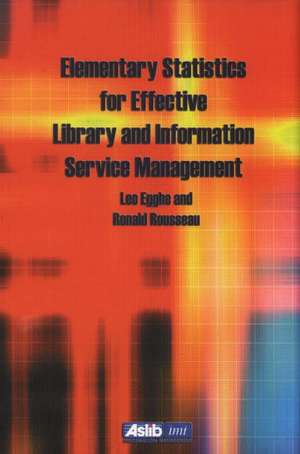Elementary Statistics for Effective Library and Information Service Management
Autor Leo Egghe, Ronald Rousseauen Limba Engleză Paperback – feb 2001
| Toate formatele și edițiile | Preț | Express |
|---|---|---|
| Paperback (1) | 461.03 lei 43-57 zile | |
| Taylor & Francis – feb 2001 | 461.03 lei 43-57 zile | |
| Hardback (1) | 986.91 lei 43-57 zile | |
| Taylor & Francis – 15 aug 2017 | 986.91 lei 43-57 zile |
Preț: 461.03 lei
Preț vechi: 542.39 lei
-15% Nou
Puncte Express: 692
Preț estimativ în valută:
88.25€ • 95.89$ • 74.17£
88.25€ • 95.89$ • 74.17£
Carte tipărită la comandă
Livrare economică 21 aprilie-05 mai
Preluare comenzi: 021 569.72.76
Specificații
ISBN-13: 9780851424514
ISBN-10: 0851424511
Pagini: 126
Ilustrații: bibliography, index
Dimensiuni: 156 x 234 x 7 mm
Greutate: 0.45 kg
Ediția:1
Editura: Taylor & Francis
Colecția Routledge
Locul publicării:Oxford, United Kingdom
ISBN-10: 0851424511
Pagini: 126
Ilustrații: bibliography, index
Dimensiuni: 156 x 234 x 7 mm
Greutate: 0.45 kg
Ediția:1
Editura: Taylor & Francis
Colecția Routledge
Locul publicării:Oxford, United Kingdom
Cuprins
Introduction Part 1: Information about the library 1.1 Reports 1.2 Data gathering 1.3Data gathering in an electronic environment 1.4 Complete and incomplete data 1.5 How to sample 1.5.1 Random sampling 1.5.2 Systematic sampling 1.5.3 The Fussler sampling method 1.5.4 Structural sampling 1.6 What to sample 1.6.1 Collection 1.6.2 User Services 1.6.3 Automation and catalogue aspects 1.6.4 The personal 1.6.5 External relations 1.6.6 Budgets 1.6.7 Data on companies involved in the library's activities 1.7 Measuring scales 1.7.1 Normal scale 1.7.2 Rank order scale 1.7.3 Interval scale 1.7.4 Difference and ratio scales 1.7.5 Absolute scale Part 2: Descriptive statistics 2.1 Graphical aspects of data 2.1.1 Mathematical functions 2.1.2 Graphical representation of data 2.1.3 Problems with graphical representation 2.1.4 Scatterplots and regression lines 2.2 Measuring central tendencies and irregularity of data 2.2.1 The mean of average 2.2.2 The variance and the standard deviation 2.2.3 Median, quartile, percentile 2.2.4 Applications: box-whisker plots, 80/20 rule, Lorenz curves 2.2.5 Calculation of the equation of the regression line Part 3: Inferential statistics 3.1 Goal of part 3 3.2 First test for the mean: one sample and one set of measurements 3.3 Consequence of the first test of the mean: confidence intervals for the population mean µ 3.4 Second test for the mean: one sample but with two sets of measurements 3.5Third test for the mean: two samples 3.6 Sample sizes 3.6.1 Rough Argument 3.6.2 Logical correction and refinement 3.7Confidence intervals and sample sizes for multinomial fractions 3.7.1 Introduction 3.7.2 The correct method for determining multinomial confidence intervals 3.7.3 Sample sizes for multinomial confidence intervals 3.8 Epilogue: test for the quality of regression line of a scatterplot - the correlation coefficient Conclusion Appendix 1. Table of random number Appendix 2. Logic of calculations Appendix 3. Basic arithmetic on pocket calculators Appendix 4. List of notation Bibliography Subject Index
Descriere
Describes how to use statistical data to produce professional reports on library activities.




